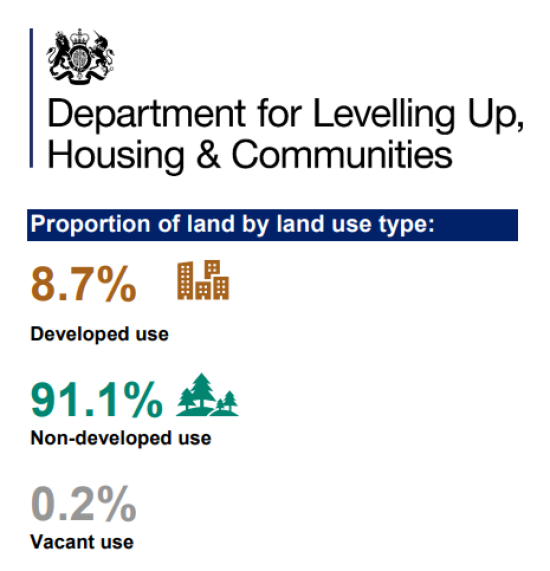New DLUHC statistics show that the perception that most new development is gobbling up our green and pleasant land is at odds with reality.

In statistics published by the Department of Levelling Up, Housing and Communities on 27th October, the amount of developed land within England has been fully assessed.
DLUHC confirm that only 8.7% of land is developed, leaving circa 91.1% non-developed (the balance of 100% being classified as vacant).
The general attitude portrayed by politicians (from all parties), reiterated by the new PM Rishi Sunak in his leadership campaign is that swathes of the Green Belt are being lost to development and that the development industry is failing to develop brownfield sites first.
Undeveloped land is classed as; agricultural, forestry, open land, water, residential gardens, outdoor recreation.
Just over 37.4% of England is afforded additional protection form development (Green Belt, National Parks and Areas of Outstanding Natural Beauty). In addition, some areas (not specifically recorded with the analysis) will be subject to other land use protection policies, such as Local Green Spaces, land within the curtilage of listed buildings, village greens etc.
10.5% of developed land this land is in main conurbations such as London, Birmingham, Bristol, Leeds, Newcastle, Liverpool and Manchester with London having (understandably) the highest proportion of land of developed use.
The statistic also show that 54% of new residential addresses created between 2021-2022 were created on previously developed land. Whilst this is a decrease of 12%, compared to the figures from 2020-2021, it demonstrates that most new addresses are delivered on previously developed land. Notably, only 2% of new addresses have been created upon land formally designated as Green belt.
The statistics show a contrary picture to political rhetoric. Whilst no one would advocate building on green fields in preference to brownfield land, the truth behind the statistics is that brownfield sites are not located where greatest demand exists, added to this successive government policy guidance which acts as a disincentive to developers to prioritise the redevelopment of brownfield land.
This coupled with the economic and political system making it very difficult for local authorities to plan appropriately for growth and the result is an appeal led system predicated on a lack of housing supply all fuelling the settled community’s perception that unwanted development is been forced upon them.
For further advice on your project or development, email mark.campbell@evansjones.co.uk
